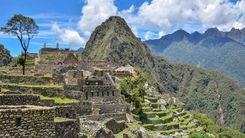Once the site of a bloody battle between Inca leaders and the Spanish conquistadores, today the most dramatic event to take place at Sacsayhuaman is the colourful – if overly commercial – Inti Raymi festival in June. However, throughout the year, you may stumble across various sun ceremonies being performed here by local mystics.
Brief history
It was the Emperor Pachacuti who began work on Sacsayhuaman in the 1440s, although it took nearly a century of creative work to finish it. Various types of rock were used, including enormous diorite blocks from nearby for the outer walls, Yucay limestone from more than 15km away for the foundations, and dark andesite, some of it from over 30km away at Rumicolca, for the inner buildings and towers. First, boulders were split by boring holes with stone or cane rods and wet sand; next, wooden wedges were inserted into these holes and saturated to crack the rocks into more manageable sizes; finally the blocks were shifted into place with levers. With only natural fibre ropes, stone hammers and bronze chisels, it must have been an enormous task.
During the fateful battle of 1536, Juan Pizarro, Francisco’s son, was killed as he charged the main gate in a surprise assault, and a leading Inca nobleman, armed with a Spanish sword and shield, caused havoc by repulsing every enemy who tried to scale Muyu Marca, the last tower left in Inca hands. Having sworn to fight to the death, he leapt from the top when defeat seemed inevitable, rather than accept humiliation and dishonour. After the battle the esplanade was covered in native corpses: food for vultures and inspiration for the Cusco coat of arms, which, since 1540, has been bordered by eight condors “in memory of the fact that when the castle was taken these birds descended to eat the natives who had died in it”. The conquistadors wasted little time in dismantling most of the inner structures of the fortress, using the stones to build Spanish Cusco.
The walls
Protected by such a steep approach from the town, the fortress only needed defensive walls on one side. Nevertheless, this “wall” is one of South America’s archeological treasures, actually formed by three massive, parallel stone ramparts zigzagging together for some 600 metres across the plateau just over the other side of the mountaintop from Cusco city and the valley below. These zigzag walls, incorporating the most monumental and megalithic stones used in ancient Peru, form the boundary of what was originally designed as a “spiritual distillation” of the ancient city below, with many sectors named after areas of imperial Cusco.
Little of the inner structures remain, yet these enormous ramparts stand twenty metres high, quite undamaged by past battles, earthquakes and the passage of time. The strength of the mortarless stonework – one block weighs more than three hundred tonnes – is matched by the brilliance of its design: the zigzags, casting shadows in the afternoon sun, not only look like jagged cats’ teeth, but also seem to have been cleverly designed to expose the flanks of any attacking force. Recently, however, many sacred and ritual objects excavated here have caused archeologists to consider Sacsayhuaman as more of a ceremonial centre than a fortress, the distinctive, jagged form of these outer walls possibly symbolizing the important deity of lightning.
The towers and temple
Originally, the inner “fort” was covered in buildings, a maze of tiny streets dominated by three major towers. The tower of Muyu Marca, whose foundations can still be seen clearly, was round, over 30m tall and with three concentric circles of wall, the outer one roughly 24m in diameter. An imperial residence, it apparently had lavish inner chambers and a constant supply of fresh water, carried up through subterranean channels. The other two towers – Salla Marca and Paunca Marca – had rectangular bases about 20m long and were essentially warriors’ barracks, and all three were painted in vivid colours, had thatched roofs and were interconnected by underground passages: in its entirety, the inner fortress could have housed as many as ten thousand people under siege. At the rear of this sector, looking directly down into Cusco and the valley, was a temple dedicated to the sun, reckoned by some to be the most important shrine in the entire Inca Empire and the most sacred sector of Sacsayhuaman. Excavation of these sites continues, but it’s still very difficult to make out anything but the circular tower base.



